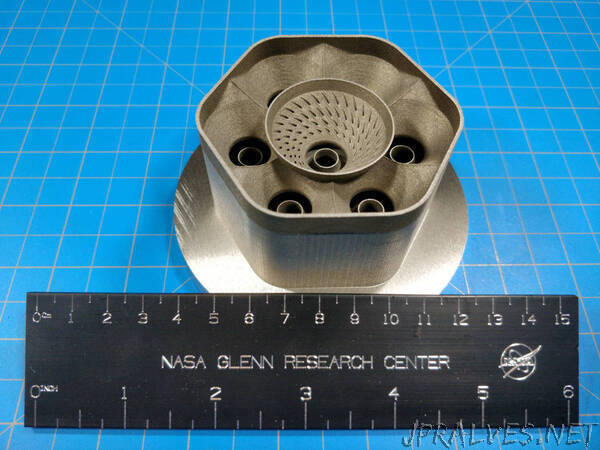
“NASA innovators recently developed a new metal alloy using a 3D printing process that dramatically improves the strength and durability of the components and parts used in aviation and space exploration, resulting in better and longer-lasting performance.
NASA Alloy GRX-810, an oxide dispersion strengthened (ODS) alloy, can endure temperatures over 2,000 degrees Fahrenheit, is more malleable, and can survive more than 1,000 times longer than existing state-of-the-art alloys. These new alloys can be used to build aerospace parts for high temperature applications, like those inside aircraft and rocket engines, because ODS alloys can withstand harsher conditions before reaching their breaking point.
“The nanoscale oxide particles convey the incredible performance benefits of this alloy,” said Dale Hopkins, deputy project manager of NASA’s Transformational Tools and Technologies project.
It’s challenging and expensive to produce ODS alloys for these extreme environments. To develop NASA Alloy GRX-810, agency researchers used computational models to determine the alloy’s composition. The team then leveraged 3D printing to uniformly disperse nanoscale oxides throughout the alloy, which provides improved high-temperature properties and durable performance. This manufacturing process is more efficient, cost effective, and cleaner than conventional manufacturing methods.
Impacts and Benefits
These alloys have major implications for the future of sustainable flight. For example, when used in a jet engine, the alloy’s higher temperature and increased durability capability translates into reduced fuel burn and lower operating and maintenance costs.
This alloy also affords engine part designers new flexibilities like lighter materials paired with vast performance improvements. Designers can now contemplate tradeoffs they couldn’t consider before, without sacrificing performance.
Breakthrough Performance: A Revolution in Materials Development
NASA’s new alloys deliver enhanced mechanical properties at extreme temperatures. At 2,000° F, GRX-810 shows remarkable performance improvements over current state-of-the-art alloys including:
Twice the strength to resist fracturing
Three and a half times the flexibility to stretch/bend prior to fracturing
More than 1,000 times the durability under stress at high temperatures
“This breakthrough is revolutionary for materials development. New types of stronger and more lightweight materials play a key role as NASA aims to change the future of flight,” said Hopkins. “Previously, an increase in tensile strength usually lowered a material’s ability to stretch and bend before breaking, which is why our new alloy is remarkable.”
Discovery/Development: Coupling Additive Manufacturing with Material Modeling
The team applied thermodynamic modeling and leveraged 3D printing to develop the new high-temperature alloy that delivered this breakthrough performance.
“Applying these two processes has drastically accelerated the rate of our materials development. We can now produce new materials faster and with better performance than before,” said Tim Smith, a material research scientist at NASA’s Glenn Research Center in Cleveland and one of the inventors of this new alloy.
“What used to take years through a trial-and-error process, now takes a matter of weeks or months to make discoveries,” added Hopkins.
Using thermodynamic modeling, one of many computational tools discussed within the NASA 2040 Vision Study, the team discovered the optimal alloy composition after only 30 simulations.
This modeling tool produces results in much less time and with lower costs than traditional trial-and-error processes. The tool also avoids dead ends by showing researchers not just what metal types to incorporate but how much of each element to infuse into the composition. “The performance of this alloy clearly demonstrates the modeling tool’s maturity and ability to produce significant results,” said Steve Arnold, materials and structures technical discipline lead at NASA Glenn.
This new alloy is just one example of how the Transformational Tools and Technologies project delivers innovative solutions through foundational research and cross-cutting tools. Watch NASA’s Additive Manufacturing Alloys for High-Temperature Applications Webinar to learn more about the technical details of this innovation and how NASA technology is available to industry and other organizations.”
